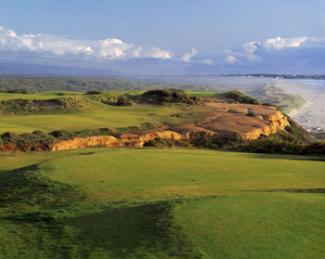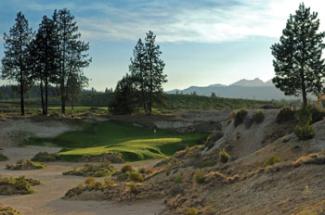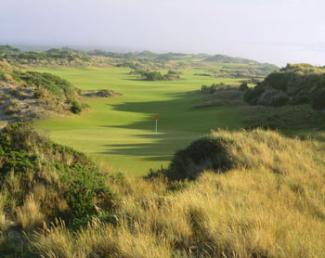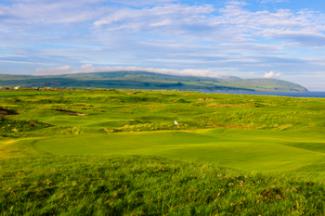Featured Golf News
Favorite Designers: David McLay Kidd
Editor's Note: In each month of 2011 Cybergolf correspondent Tony Dear will cover his favorite course designers and explain why he rates them so highly. Now up: David McLay Kidd.

David McLay Kidd
What's your definition of greatness? Can a schoolteacher be thought of as a great educator if he helps guide the gifted egghead into Harvard, or must he also be capable of enabling the once-hopeless troublemaker scrape enough good grades to get into community college? Which is greater: the golf instructor that guides a plus-6 handicapper on to the professional tours, or the guy or gal who helps transform a 36-handicap hack into a single-digit?
Likewise, which golf course architect is more deserving of the label - the individual who takes a gently undulating, sand- and gorse-covered dune-scape that could not be any better suited to the game and molds it into a world top-100 course, or the guy who, presented with a flat, barren, poorly-drained wasteland - one surrounded by the majesty of the Grand Tetons, but a wasteland all the same - somehow produces an endlessly engaging golf course worthy of numerous 'Best New' awards?
That the same man should be responsible for creating both Bandon Dunes and Huntsman Springs, respectively - and plenty more notable courses in diverse locations - demonstrates a level of competence and expertise that few in the field can boast.
David McLay Kidd, son of greenkeeping legend (if greenkeepers can be legends) Jimmy Kidd and a graduate of Writtle College in Essex, England, has been at the pinnacle of his profession for a little over a decade now, ever since he burst onto the scene with his superb cliff-top links course along the Oregon coast that established him, at age 32, as a designer of exceptional talent. Now, at 44, Kidd has almost a dozen more outstanding courses in the books, a couple of them criticized for being too severe in places, but all of them unforgettable.
We speak as the proud Scotsman is stuck at San Francisco Airport waiting for a plane to Inchon, South Korea, where he is currently building his first course in Asia. Two years ago Kidd told writer John Strawn he would be attempting to target new markets, such as Asia, from his base in the U.S. In an interview with Golf Digest earlier this year, however, Kidd said he had no interest in working in that part of the world, especially China, saying "every man and his dog" was there and that he wasn't particularly interested in the sort of jobs developers were offering.

16th Hole at Bandon Dunes (Photo by Wood Sabold)
Business is business, however, and with so little design work available in the U.S., Kidd took the plunge and has, in fact, been pleasantly surprised by the level of sophistication and golf knowledge he has encountered.
"I know there will be a few very grand projects like Mission Hills Hainan, where size is everything and where the courses are extremely expensive to construct and maintain, but I think they are beginning to understand about restricting water and chemical use over there," he says. "They recognize the typical country club excesses probably can't work in most situations, and that they can't all aspire to be like Augusta National."
Kidd is now optimistic about golf in Asia to the point of talking about the possibility of a second "Golden Age" with the likes of Tom Doak, Bill Coore and Ben Crenshaw, Gil Hanse, Kyle Phillips and himself building great courses on the other side of the Pacific with relatively small budgets . . . should they wish to.
"If another Golden Age was to happen, it certainly wouldn't be in the U.S.," he says. "The patient is all but dead in America. Everything is real estate-based and the sort of big-budget facilities we saw open throughout the '90s and first part of this century won't be coming back any time soon. What courses are built in the U.S. in future will be, at least should be, determined by demographics and demand, not the whims of affluent developers."

Huntsman Springs
At His Creative Best
In 2009, Kidd was fortunate enough to work for one of America's most affluent people, although it should be pointed Jon Huntsman isn't your typical developer and the creation of his course in Driggs, Idaho, wasn't motivated by a selfish need to top any rankings or supplement his income.
The man once listed as the 47th richest in the world thanks to the success of his packing and chemical companies, built his course in order to protect the environment and provide jobs in the corner of Idaho where he grew up, as well as make sizeable contributions to the Huntsman Cancer Institute at the University of Utah, which the Huntsman Family founded in 1995 with a pledge of $100 million (another $125 million came soon after).
Kidd was introduced to Huntsman by a photographer friend and first visited the 1,360-acre property in January of '09. "I knew the Huntsmans had met with a few other firms but hadn't really gotten a good vibe," he says. "To be honest, I wasn't surprised. (The temperature) was four degrees, the place was covered in a few feet of snow, and it looked really flat and featureless. I would have left right then and never had anything else to do with the place if it weren't for the Huntsman family. I actually felt kind of bad for them because it was such a dismal site."
David Huntsman, son of Jon Huntsman Sr., brother of Republican Party Presidential nominee Jon Huntsman Jr., and the course's CEO, met Kidd at a restaurant in Driggs that evening and says he knew within 10 minutes he was their man. "David really spoke our language," says Huntsman. "He talked about the challenges and how he would overcome them. He was very passionate about the project, and told us bluntly that he would need to experiment a lot but that we would need to trust him. There was a bit of political charades going on, and in the end I think it boiled down to him choosing us rather than us choosing him."

Tetherow Resort
Huntsman adds he could not have been happier with the decision, and that he became very impressed with Kidd's hands-on approach. "I would make random visits to the course to check on progress and I'd unexpectedly bump into David," he recalls. "He was at the course far more often than I believe is usual for well-known course designers. I had spoken with Tom Fazio and a representative from Jack Nicklaus's design firm and got the impression the actual work would have been done by their staff while they made well-publicized appearances at the start and toward the end of construction. Really, I can't say enough good things about David Kidd."
Kidd's interest in the job had perked up considerably before the meeting in the restaurant after he learned about the site's geology. "I was told about the sub-surface boulders, the gravel, the springs of natural melt-water and the 11,000 acres of sand close by in St. Anthony," he says. "And I knew the ground couldn't be entirely flat because it drained into the Teton River just to the west of where the golf course would be. It turned out there was 20 feet of fall from the top of the site down to the river, which doesn't sound like much but it was plenty for what I needed."
Kidd devised a figure-8 routing in which excavated earth could be piled high in the center to create elevated home sites while the golf course would sit in the depressions below.
The plan worked well in theory, but would require an outrageous 4 million cubic yards of earth to be dug up and 450,000 cubic yards of sand to go down to guarantee good drainage. The course's five stone bridges made with Montana moss rock cost a million dollars each. It all added up to a budget of over $20 million.
The money wasn't a problem, of course, and, as Kidd says, without the earth movement the course wouldn't have amounted to anything much. Fifty acres of wetlands were also created during construction, attracting wildlife that wasn't there before.
"The team I worked with were all local guys and obviously knew the land very well," says Kidd. "They did a fantastic job of replicating the area's natural wetlands on the golf course. People often ask me how we got permission to build a course through all those wetlands and are amazed when I tell them it was us that put them there."
The result, when you consider what Kidd saw on his first visit, is nothing short of brilliant. The generally-accepted definition of what makes a course great - one that keeps the scratch golfer honest while never breaking the high-handicapper's spirit - is met here as well as anywhere. To break 70 at Huntsman Springs you will need to be very good. To top 100, you will have to be quite bad. It's beautiful, fun, exciting, stimulating and everything else a great course should be (apart from old perhaps).
And it's perfectly understandable why Kidd considers this course his biggest architectural achievement. "It was a massive undertaking," he says. "It wouldn't have been possible without the patience and financial resources of the Huntsman family, and in a way I'm thankful they weren't golfers because that enabled me to experiment so much. There's no way an experienced golf course developer would have allowed me to try some of the things we did."

13th Hole at Castle Course
To Bandon via Gleneagles & Kathmandu
Kidd would not have been considered for the lead design job at Huntsman Springs, or those at Tetherow in Bend, Ore., TPC Stonebrae in Hayward, Calif., and Nanea on Hawaii's Big Island - all of them critically acclaimed - had he not made the most of his fortuitous appointment at Bandon Dunes in 1994. And Bandon Dunes would never have happened if Kidd hadn't gained valuable experience working for both Howard Swan's design firm based in Ongar, Essex, and later as director of design at Gleneagles Golf Developments (GGD). The fact he was Scottish would also prove pretty useful.
"Gleneagles Golf Developments had plans for 10 golf resorts around the world, but the recession of the early '90s put a stop to that," says Kidd. "Fortunately, I was part of a small group that didn't lose their jobs, and we were able to advertise our services to third parties. Among the offers we received was a proposal to build a course near Kathmandu. Nepal had four nine-holers at the time, but this was to be its first 18-hole course."
Located an hour outside the capital where the Gokarneshwar Mahadev Temple - dedicated to the god Shiva - stands on the banks of the holy Bagmati River, the Gokarna Forest course is quite the experience with the Himalayan foothills in the background, deer and monkeys roaming freely, deadly poisonous kraits hidden in the trees, and the threat of tigers still around despite one not having been seen there for several years.
And, depending on the country's fragile political state, there may well be military personnel nearby, too. "I was totally oblivious to the dangers," says Kidd, who worked in Nepal around the time the country's Communist Party began its attempt to overhaul the parliamentary monarchy using a Mao-inspired people's war. "I have never been back and never played the course. But I hear it turned out pretty well."
While spending weeks at a time in Nepal, Kidd was also gearing up for construction of his first course in America. He had first set eyes on Bandon's wild sand dunes and wilder gorse in the summer of 1994 after the 1,200-acre property's owner Mike Keiser had decided to hire a Scottish designer, rather than a big-name American, to build his links course. Gleneagles Golf Developments had been recommended to Keiser by golf entrepreneur Rick Summers, who was involved with GGD and knew Jimmy Kidd well.
It was Ian Ferrier, the head of GGD, who first visited Keiser in Chicago and then the site itself, however. His company hadn't actually finished a single course at that stage, but Ferrier was able to convince Keiser they would be capable of building Bandon Dunes.

5th Hole at Bandon Dunes
(Photo by Wood Sabold)
Kidd first went to Bandon with his father, spending the summer of '94 clearing the gorse and trying their best to configure a routing. They stayed in a cheap motel in town. "The first routing we came up with bears very little resemblance to how the course eventually turned out," says Kidd, who wasn't sure how long his services would be required. Even after Keiser had officially hired him, the then 27-year-old Kidd never truly believed it would be his name above the door, so to speak, "I didn't know what sort of man Mike was back then," he recalls. "I thought he could take advantage of our experience and knowledge, and dump us at any moment before getting Nicklaus or whoever to come in and build it."
Indeed, Keiser admits it wasn't really until holes 4-8 became part of the routing - long after the Kidds had begun work at Bandon - that he knew hiring Kidd the Younger was the right move. "Up until then, David was right about his 'uncertain status,' " says the resort's owner.
Kidd sees it slightly differently. "The fourth, 12th, 15th and 16th were the first holes I 'saw,' " he says. "But it was the design of the 16th specifically that was so crucial to gaining Mike's confidence." The green at the short par-4 had originally been positioned a little inland from where it is now, but Kidd decided to move it to the cliff's edge.
"One morning, Mike turned up with Mike Davis (now the USGA's executive director, then the Championship Director of the U.S. Open) and saw the new hole for the first time. His eyes were as big as saucers but I didn't know what he was thinking. I thought he might fire me on the spot, but he said nothing."
Keiser remembers the moment well. "I liked it immediately," he says. "But I took my time 'finally deciding,' partly because David was clearly worried about my reaction."
You'd think Kidd would put the 16th right at the top of his list of favorite Bandon holes, but it's actually the 14th that gets his vote. "It's not right on the ocean and it definitely wasn't one of the most obvious holes when I came up with the initial routing," he says now. "But with careful bunker placement, we built a hole that challenges everybody by forcing them to decide a suitable line off the tee. It might not be everyone's favorite at Bandon, but it's the hole I cherish most."

The 6th Hole at Machrihanish Dunes
Working from Home
It had been five years in the making, but Bandon Dunes made David Kidd an almost instant celebrity, in America at least. Though he had drawn up numerous master plans and designs for Howard Swan and Gleneagles Golf Developments, his only solo design in Britain was Colne Valley just north of London, a low-budget affair that took just 12 weeks to build. It wasn't for another couple of years after Bandon that Kidd, who now lived in London, was finally given the chance to prove his talent in the U.K., and then at a course so exclusive only a tiny percentage of British golfers has so much as seen a photograph.
Many regard Queenwood GC in Ottershaw, Surrey, as the U.K.'s equivalent to Augusta National, the difference being Queenwood doesn't host a televised tournament every year and is therefore significantly more mysterious. Its membership includes a handful of world-ranked players who pay a reported £145,000 joining fee not only for a great course but also superb practice facilities and course conditions similar to those at the home of the Masters.
The developer, Fred Green, who also built the very private Eagle Springs GC in Wolcott, Col., and Nantucket GC in Nantucket, Mass., originally intended Nicklaus or Tom Fazio to build him an American-style country club, but Kidd advised against it.
"A lot of the big-money country club-style courses that had sprung up around London - clubs like East Sussex National, the Oxfordshire and the London Club - were too manicured and predictable, and were failing to one degree or another," says Kidd. "I put an aggressive pitch to Fred telling him something similar just wouldn't work. I told him he should try to recreate something like Swinley Forest or Sunningdale. It didn't take him long to change his mind."
Kidd plated the whole site with sand and introduced heather, a fundamental component of any heathland course. "It took a few years, but now it really does have the look and feel of those heathland classics," says Kidd.
His next opportunity on his side of the Pond actually came in Ireland at the Powerscourt Estate in County Wicklow, 15 miles south of Dublin. The West Course there was another fine effort, but again, because it was a relatively low-budget minimalist design and most visitors to Ireland are drawn to the famous links courses, it has never received the amount of play or level of attention that Bandon Dunes does.

No. 9 at Machrihanish Dunes
Seventh Heaven
It wasn't long, however, before Kidd was receiving more attention than any other golf course architect on the planet. In 2001, The St. Andrews Links Trust revealed plans for the Auld Grey Toon's seventh golf course and Kidd, who flew to Scotland from Hawaii where he was working on Nanea to interview for the job, was chosen to build it.
"There were rumors that Nicklaus was going to design the course for free," says Kidd. "But in the end I think they liked the idea of a Scotsman doing it, plus the fact I intended working very closely with the Links Trust's green-keeping staff."
Given how infrequently new courses came along at St. Andrews, the commission was obviously a once-in-a-lifetime opportunity for Kidd, but he was surprised when Alan McGregor, general manager of the Links Trust, and Gordon Moir, its head superintendent, showed him the site. "I assumed it would be over by the Strathtyrum estate to the west of town," he says, "so I was shocked when they headed east (on the A917)."
The site for what would become the most talked-about course of the year or decade was a flat, 220-acre potato field with bad drainage. It was set on cliffs (braes) above the North Sea and did overlook the town, but the £2.5million budget wasn't nearly enough for what Kidd had in mind. "I considered how to approach it for two years," he says. "I could have gone really minimalist like Gil Hanse at Craighead, but I wanted to do something more inspiring. I wanted it to be bold."
Kidd plated the site with sand and designed the course around the 17th and 18th holes, a spectacular par-3 played from one brae to another and a fine dogleg-right par-5 finishing on a shallow peninsula green. Conditions were firm and fast - a remarkable accomplishment given the clay foundations he started with, but some criticized the course, saying Kidd had gone too far with some of the shaping and links 'accessories.'
The critics certainly had a point. The Castle Course (it was given the name following a competition that attracted over 4,000 entries) was actually something of a links theme park with its scattered pot bunkers, fescue-covered mounding and extreme contouring.
"I knew that would be the reaction of many," says Kidd. "I expected some people not to like it. But we (Kidd and design partner Paul Kimber) built it that way anyway knowing we could soften it if necessary, and that we'd regret it for the rest of our lives if we had built something bland. I wanted the shapes to look totally random. Look at (Alister) Mackenzie's courses; he never did anything that wasn't bold. And don't forget they are still tweaking the Old Course 600 years after it was first played."
Kidd will concede he pushed the envelope a little far with some of the green surrounds and that the punishment for a slightly off-line approach shots was too severe. The course also went £1.3 million over budget. Ultimately though, he has no regrets.
Nor does he have any misgivings about his design of Machrihanish Dunes, on the west coast, which came in for similar criticism when it opened in 2009. "Machrihanish Dunes was undoubtedly the best piece of land I ever had to work on," says Kidd. "It was better even than Bandon because the dunes were perfect, it was at sea level and the gorse was relatively tame, compared with a rampant, noxious weed that covered the entire site.
"The trouble was all the environmental restrictions we had to observe. It was a Site of Special Scientific Interest (SSSI) and you could barely take a piss without some environmentalist threatening to put you in jail." Certain areas were strictly off-limits and Kidd could only move earth on the greens and tees. Seeding was restricted to those same areas. All he could do on the fairways was mow them out, while a flock of sheep was required to maintain the rough at a decent height.
It meant the course opened in a condition that might have been regarded as passable many years ago but which didn't really fly in an age of 12-foot Stimpmeter readings, perfectly even rough and carpet-like fairways. The silver lining was that Kidd was able to build the course for just £1.5 million. And now that the course has been awarded GEO (Golf Environment Organization) Certification, thanks to two years of careful maintenance, the greenkeeping staff has been allowed certain concessions and is now able to cut the rough with mowers.
"There are a few changes going on there now," says Kidd, who owns a stake in the course. "My dad's there making the fairways a little wider and softening some of the edges. It's really a similar story to what's happening at the Castle Course. Given time it will soften and become ever more playable. Really it had to be that way because we just weren't allowed to do the things we're doing now when we started."
That's encouraging certainly but the problem, says Kidd, is that the power of the media is so strong the reputation the course gained from the early reviews is going to be hard to change. "People wrote that the course was almost unplayable and over the top, and that's the image that sticks," he says. "But it's different now to what people saw on day one and it will be even more different next summer."
Hopefully by then, Machrihanish Dunes will have matured a little more into the great links Kidd envisioned years ago when he walked these dunes as a boy.
Great Possibilities at Gamble Ranch
Besides the job he is just about to fly to South Korea to work on, Kidd tells me about a few other projects that are keeping his head above water, albeit with a reduced staff; his UK office has closed and he had to let Kimber go at the end of 2009. There was Luacala, the course he built for Dietrich Mateschitz (the energy behind Red Bull) on the Austrian billionaire's private island in the Pacific Ocean; Comporta Dunes in Portugal, which eventually will sit beside Tom Fazio's Comporta Links at a €1 billion development on the Atlantic coast an hour south of Lisbon; and gWest (yes, that's its name) in the Scottish Highlands, which is actually complete but has yet to open.
Botanica on the Nicaragua coastline is under construction, Taghazout Beach Resort in Morocco is more or less complete, and Singapore-based Amanresorts has commissioned Kidd for a course in Bahia, Mexico.
There was also been a little renovation work - on the Centenary Course at Gleneagles, Ljunghusens in Sweden, and Durban CC in South Africa, although Kidd says he is not particularly interested in that side of the business and has all but stopped seeking any 're-work.'
While the projects he has lined up and are under construction certainly do have Kidd's attention, nothing excites him right now as much as a site in north-central Washington State where, next spring, Kidd will begin building a course that he thinks could be the next Sand Hills.
With so little activity in America, Kidd knows the spotlight will shine squarely on Gamble Ranch (owned by a family of fruit farmers and located outside the town of Brewster overlooking the Columbia River), and that if it is to be even mentioned in the same sentence as Bill Coore and Ben Crenshaw's Nebraska masterpiece, he will have to produce his very best work and resist the temptation to showcase his full box of tricks, a trap he concedes he fell into at Tetherow and the Castle Course.
"My philosophy has evolved over the years," he says. "I was perhaps guilty of wanting to do too much on every course, which sometimes affected its playability. But now I'm all about playability, and Gamble Ranch is an absolutely amazing site with no housing element, great views and loads and loads of sand. It will be relatively inexpensive to build and maintain too."
Who knows? If Gamble Ranch turns out even half as well as Kidd thinks it might, it could very well one day be considered part of that second Golden Age of golf course design that Kidd doesn't think can possibly happen. And he would inevitably take his place, if he hasn't already, among the elite of golf course architects, building classic courses that golfers 100 years in the future will enjoy every bit as much as we do now.
That, surely, is the essence of great design.
Tony Dear is an Englishman living in Bellingham, Wash. In the early 1990s he was a member of the Liverpool University golf team which played its home matches at Royal Liverpool GC. Easy access to Hoylake made it extremely difficult for him to focus on Politics, his chosen major. After leaving Liverpool, he worked as a golf instructor at a club just south of London where he also made a futile attempt at becoming a 'player.' He moved into writing when it became abundantly clear he had no business playing the game for a living. A one-time golf correspondent of the New York Sun, Tony is a member of the Golf Writers Association of America, the Pacific Northwest Golf Media Association and the Golf Travel Writers Association. He is a multi-award winning journalist, and edits his own web site at www.bellinghamgolfer.com.
Story Options
 |
Print this Story |
